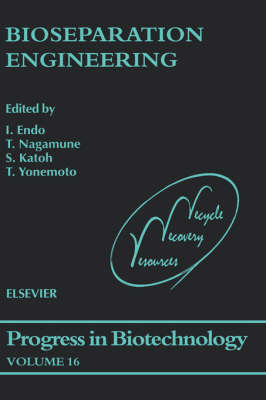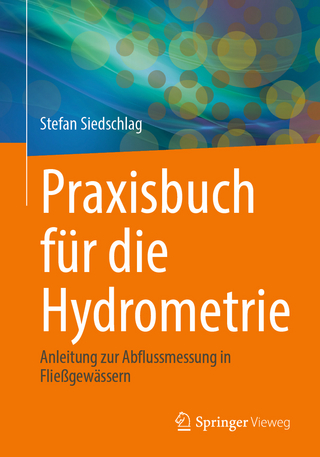
Bioseparation Engineering
Elsevier Science Ltd (Verlag)
978-0-444-50441-8 (ISBN)
- Titel ist leider vergriffen;
keine Neuauflage - Artikel merken
The bioseparation engineering of today includes downstream process engineering such as waste water, material and gas treatment. Taking this tendency into account, bioseparation engineers gathered in Japan as a special research group under the main theme of "Recovery and Recycle of Resources to Protect the Global Environment".
The scope of this book is based on the conference, and deals not only with recent advances in bioseparation engineering in a narrow sence, but also the environmental engineering which includes waste water treatment and bioremediation. The contributors of this book cover many disciplines such as chemical engineering, analytical chemistry, biochemistry, and microbiology.
Bioseparation Engineering will stimulate young engineers and scientists who will develop bioseparation engineering further in the 21st century, and contribute to a world-wide attention to the global environment
Contents. Preface. Acknowledgements. Chapter 1. Adsorption, Chromatography and Membrane Separations. Recent advances in membrane technology that could improve resource recovery and recycle: Fluid mechanics, surface science and bioaffinity (G. Belfort). Stabilization of target protein during bioseparation (X.-L. Feng, Y.-T. Jin, Z. -G. Su). Bioseparation of natural products (C. Keim, M.R. Ladisch). On-line recovery of large molecules from mixture solution using semi-continuous size exclusion chromatography (Y.-M. Kim, W. -J. Chang, Y. -M. Koo). Dye adsorption by activated carbon in centrifugal field (C.-C. Lin, H.-S. Liu). Formation and structural change of cake during crossflow microfiltration of microbial cell suspension containing fine particles (T. Tanaka, N. Yamagiwa, T. Nagano, M. Taniguchi, K. Nakanishi). Continuous separation of ternary mixture of amino acids using rotating annular chromatography with partial recycle of effluent (T. Fukumura, V.M. Bhandari, A. Kitakawa, T. Yonemoto). Mass transfer characteristics of a perfusion-type gel analyzed by shallow bed method (M. Terashima., S. Nishimura, H. Yoshida). Fouling of cheese whey during reverse osmosis and precipitation of calcium phosphate (H. Tsuge, Y. Tanaka, N. Hisamatsu). Separation of dead cells from culture broth by using dielectrophoresis (M. Hakoda, N. Shiragami). Microcalorimetric studies of interactions between proteins and hydrophobic ligands in hydrophobic interaction chromatography: Effects of ligand chain length, density, and the amount of bound protein (F. -Y. Lin, W.-Y. Chen, R.-C. Ruaan, H. -M. Huang). Membrane phase separation of aqueous/alcohol biphase mixture and its application for enzyme bioreactor (Y. Isono, M. Nakajima). Microfabricated structures for bioseparation (J.W. Hong, K. Hosokawa, T. Fujii, M. Seki, I. Endo). Production of a human IgM-type antibody and preparation of combinatorial library by recombinant Saccharomyces cerevisiae (N. Shiomi, K. Murao, H. Koga, S. Katoh). Dynamic binding performance of large biomolecules such as &Ugr;-globulin, viruses and virus-like particles on various chromatographic supports (S. Yamamoto, E. Migawa). Effects of swelling pressure of resin and complex formation with a counter-ion on the apparent distribution coefficient of a saccharide onto a cation-exchange resin (S. Adachi, R. Matsuno). Separation behavior of proteins near the isoelectric points in electrostatic interaction (Ion exchange) chromatography (T. Ishihara, S. Yamamoto). Chapter 2. Refolding Processess for Protein. Large-scale refolding of therapeutic proteins (J. Honda, H. Andou, T. Mannen, S. Sugimoto). Novel method for continuous refolding of protein with high efficiency (S. Katoh, Y. Katoh). Novel protein refolding by reversed micelles (M. Goto, T. Fujita, M. Sakono, S. Furusaki). Development of efficient protein refolding systems using chaperonins (J. Kohda, A. Kondo, T. Teshima, H. Fukuda). Monitoring structural changes of proteins on solid phase using surface plasmon resonance sensor (T. Mannen, S. Yamaguchi, J. Honda, S. Sugimoto, A. Kitayama, T. Nagamune). Chapter 3. Partitioning and Extraction. Recent advances in reversed micellar techniques for bioseparation (S. Furusaki, S. Ichikawa, M. Goto). A novel method of determining the aggregation behavior of microemulsion droplets (W.-Y. Chen, C.-S. Kuo, D.-Z. Liu). Preparation of temperature-sensitive antibody fragments (M. Kamihira, S. Iijima). Stability enhancement of &agr;-amylase by supercritical carbon dioxide pretreatment (H.-S. Liu, Y.-C. Cheng). Behavior of monodispersed oil-in water microsphere formation using microchannel emulsification technique (J. Tong, M. Nakajima, H. Nabetani, Y. Kikuchi). Chapter 4. Bioseparation Engineering for Global Environment. Domestic wastewater treatment using a submerget membrane bioreactor (X. Huang, P. Gui, Y. Qian). Biosorption of heavy metal ion with penicillin biomass (T. Tan, P. Cheng). Removal of cadmium ion by the Moss Pholia flexuosa (M. Azuma, A. Obayashi, M. Kondoh, C. Kawasaki, K. Igarashi, J. Kato, H. Ooshima). The effects of additives on hydrolysis of cellulose with water under pressures (T. Funazukuri, M. Hirota, T. Nagatake, M. Goto). Removal of volatile organic compounds from waste gas in packed column with immobilized activated sludge gel beads (K. Nakao, M.A. Ibrahim, Y. Yasuda, K. Fukunaga). Chapter 5. Industrial Separation Processes and Validations. Validation of bioprocess chromatography: Principles and practices (E.K. Lee, S. J. Ahn,). Column qualification in process ion-exchange chromatography (O. Kaltenbrunner, P.K. Watler, S. Yamamoto). Characterization of phage encoded lysis proteins and its applications for cell disruption (Y. Tanji, K. Hori, S. Yamamoto, H. Unno). Recovery of poly-&bgr;-hydroxybutyrate from recombinant Escherichia coli by a combined biologi-chemical method (J. Yin, H.-M. Yu, P.-J. Zhou, Z.-Y. Shen). Cleaning liquid consumption and recycle of biopharmaceutical plant (S. Murakami, R. Haga, S. Yamamoto). Index of authors.
| Erscheint lt. Verlag | 17.3.2000 |
|---|---|
| Reihe/Serie | Progress in Biotechnology |
| Verlagsort | Oxford |
| Sprache | englisch |
| Gewicht | 710 g |
| Themenwelt | Technik ► Umwelttechnik / Biotechnologie |
| ISBN-10 | 0-444-50441-9 / 0444504419 |
| ISBN-13 | 978-0-444-50441-8 / 9780444504418 |
| Zustand | Neuware |
| Haben Sie eine Frage zum Produkt? |
aus dem Bereich


